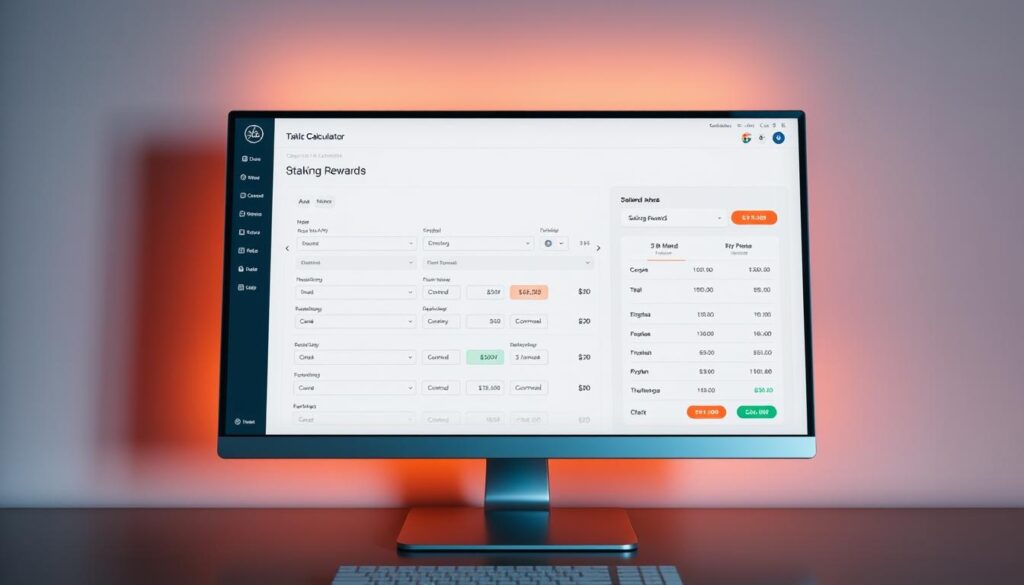Now Reading: Best Crypto Staking Rewards Calculator Platform
- 01
Best Crypto Staking Rewards Calculator Platform
Best Crypto Staking Rewards Calculator Platform

Quick, clear projections matter when you plan to earn passive income from digital assets. This service-focused page helps users model expected returns by letting them input amount, duration, and APY to see interest, future value, and periodized yield.
Use the tool to compare offers across AAVE, Lido, EigenLayer, and major exchanges so you can weigh lock-up terms, token inflation, and compounding. Results are input-driven and show minute-to-yearly breakdowns, making it easy to plan toward goals without confusing jargon.
Expect transparent estimates, not guarantees. The page walks through APR versus APY, optional compounding, and sensitivity to rate changes. If you want a fast side-by-side check, try the staking calculator to start realistic modeling and spot better opportunities.
Key Takeaways
- Tool projects returns from amount, time, and APY with clear period breakdowns.
- Designed for users comparing protocols and evaluating lock-up terms.
- Distinguishes APR (no compounding) and APY (with compounding) to reduce confusion.
- Supports quick checks and deeper scenario testing for better decision-making.
- Results are estimates based on inputs; verify program terms before committing assets.
Maximize passive income with a staking calculator built for real-world crypto decisions
Quickly translate rate assumptions into minute-to-year earnings and future value so decisions feel practical. Use clear inputs—amount, duration, and APY—to see immediate projections and total interest over time.
Key benefits: accurate APY projections, compounding, and time-based returns
Accurate APY modeling shows how small rate differences and compounding frequency change long-term income. Toggle compounding to compare monthly, daily, or continuous reinvestment and watch future value shift.
Time-based breakdowns convert complex math into minute, hourly, daily, weekly, monthly, and yearly views. That helps you align payouts with cash flow and portfolio targets.
Supported networks and tokens: ETH and leading blockchain protocols
- Compare ETH and other tokens across major networks and staking platforms like Lido, Rocket Pool, AAVE, and EigenLayer.
- Stress-test assumptions by adjusting APY, duration, and principal to see upside and downside scenarios fast.
- Neutral, data-first outputs help shortlist options with consistent reward profiles before deeper due diligence.
How our crypto staking rewards calculator platform works
See how small changes in rate, time, or amount change your projected earnings in plain dollars and token units. Start by entering the amount you plan to stake, pick a staking duration, choose APR or APY, and set a current market price to tie token payouts to dollar value.
Inputs we analyze
- Staked amount and market price to show USD equivalents.
- Staking duration and compounding frequency for time-based math.
- APY or APR selection to model compounding vs simple interest.
Outputs you get
Get total interest, future value, and granular returns per minute, hourly, daily, weekly, monthly, and yearly. These slices help match payouts to your cash-flow needs.
APR vs APY and compounding
APR is modeled as simple interest with no compounding. APY reinvests payouts; higher compounding frequency yields slightly more interest over the same duration.
ETH example
For an ETH stake of $5,000 at 5% APR over two years you’d earn about $500, total $5,500. At 5% APY with daily compounding the estimated earnings are $525.78, total $5,525.78 — about $25.78 more due to compounding.

| Scenario | Rate Type | Duration | Total Interest | Final Value |
|---|---|---|---|---|
| ETH example | 5% APR | 2 years | $500.00 | $5,500.00 |
| ETH example | 5% APY (daily) | 2 years | $525.78 | $5,525.78 |
| Comparison | APR vs APY | 2 years | $25.78 difference | — |
Quick tip: adjust rate, duration, or price in seconds to iterate scenarios. Capture snapshots and compare side-by-side to make apples-to-apples decisions. Try a detailed model at staking rewards tool.
APR, APY, and compounding: understand the yield mechanics before you stake
Understanding how interest compounds and how quoted rates are calculated helps you set realistic expectations. Read each label carefully: the difference between an annual percentage and a compounding rate changes long-term outcomes.
APR in staking
APR in staking: fixed rate without compounding
APR is a simple annual percentage applied to your original principal. It shows expected interest if you do not reinvest payouts.
This makes APR easier to estimate, but it can understate growth when compared to reinvested returns over long horizons.
APY in staking
APY in staking: reinvested rewards boost effective yield
APY reflects compounding: each payout is added back to the base and earns more interest. That raises the effective yield versus APR for the same nominal rate.
Protocols that auto-reinvest often advertise APY because it shows the higher, realized growth when compounding is active.
Compounding frequency
Compounding frequency impact on percentage yield and passive income
Daily compounding produces slightly more interest than weekly or monthly compounding for the same stated rate.
More periods per year increase the final value, though gains taper as frequency grows.

Token inflation and price volatility: aligning nominal yield with real returns
Most payouts come in the network’s native token. Token inflation can dilute unit value over time.
Price swings change dollar returns even if the number of tokens increases. Evaluate both nominal yield and expected price movement.
- Check fees and distribution schedules—they reduce realized interest versus theoretical APY.
- Compare APR vs APY based on whether you will reinvest payouts or withdraw them.
- Review on-chain factors like blockchain stability and liquidity to align expected value with realized outcomes.
| Scenario | Compounding | Effect on yield |
|---|---|---|
| 5% APR | None | Baseline interest on principal |
| 5% APY (monthly) | 12 periods | Higher final value than APR |
| 5% APY (daily) | 365 periods | Marginally higher than monthly compounding |
For practical comparisons and to see how different compounding frequencies change outcomes, review best DeFi choices at best DeFi choices.
How to use the calculator to model staking rewards with confidence
Use current rates, the amount you plan to commit, and a clear time horizon to build realistic projections. This approach helps users test scenarios across exchanges and DeFi platforms before making an investment decision.
Select realistic rates from trusted exchanges and protocols
Gather live APY or APR quotes from reputable exchanges or reputable validators. Enter a conservative number if rates are volatile.
Factor token inflation and fee schedules so your modeled outcome reflects net payouts and potential dilution.

Set staking duration and choose compounding to compare scenarios
Pick a duration that matches your liquidity needs. Toggle compounding frequency to see how reinvestment changes final value over time.
- Enter the amount, then vary the rate and time to run multiple cases fast.
- Compare time-based outputs to spot when targets are reached.
- Save scenario snapshots to compare exchanges and validators side-by-side.
Practical tip: start with shorter durations and conservative rates if you are new to the staking process. Treat the tool as a decision aid and revisit assumptions as markets shift.
Security, risks, and safeguards when using crypto staking
Assessing operational, market, and legal risks helps you keep downside exposure in check.
Volatility and token value risk: Price swings can turn attractive nominal yields into smaller dollar returns. Track market moves and stress-test scenarios so token gains aren’t offset by sudden drops in value.
Platform and counterparty risk: Review validator uptime, security audits, and historical performance. Slashing for misbehavior or downtime can reduce funds. Prefer well-known validators with solid track records.

Liquidity trade-offs and lock-up periods
Long lock-ups and unbonding windows limit access during market stress. Liquid options add flexibility but introduce smart contract risk.
Regulatory and technology risks: Rules and tax treatment can change quickly. Smart contracts and bridges can have bugs or exploits. Diversify exposure and limit single-point failures.
Practical safeguards
- Due diligence: Check audits, reserve policies, and validator history.
- Position sizing: Limit any single protocol or validator exposure.
- Record keeping: Track all actions for compliance and tax reporting.
Accuracy limits: Tools provide estimates only. Verify live rates and terms with each exchange or protocol before committing funds.
| Risk Type | Typical Impact | Mitigation |
|---|---|---|
| Price volatility | Lower dollar value of token payouts | Stress-test scenarios; use conservative price assumptions |
| Validator failure | Slashing or lost uptime | Choose reputable validators; monitor uptime |
| Illiquidity / lock-ups | Inability to exit in stress | Mix lock-up and liquid options; stagger maturities |
Transparency note: The site may include affiliate links at no extra cost. Content is educational and not financial, legal, or tax advice. Verify details directly with service providers and consult professionals for personalized guidance.
Start staking smarter today with our crypto staking rewards calculator platform
Run a quick scenario to see how amount, rate, and duration combine with compounding to meet your income goals.
Enter the amount you plan to stake, pick APR or APY, and set a realistic duration to get minute‑to‑year projections instantly.
Compare networks and protocol choices, and review ETH and token scenarios side by side to see how fees, distribution cadence, and compounding affect total reward outcomes.
Validate rate, duration, and price against live data before you commit. Start small to learn the staking process, then scale and diversify across trusted staking platforms as you gain confidence.
Run your first scenario now to uncover opportunities that match your passive income goals and risk tolerance.














